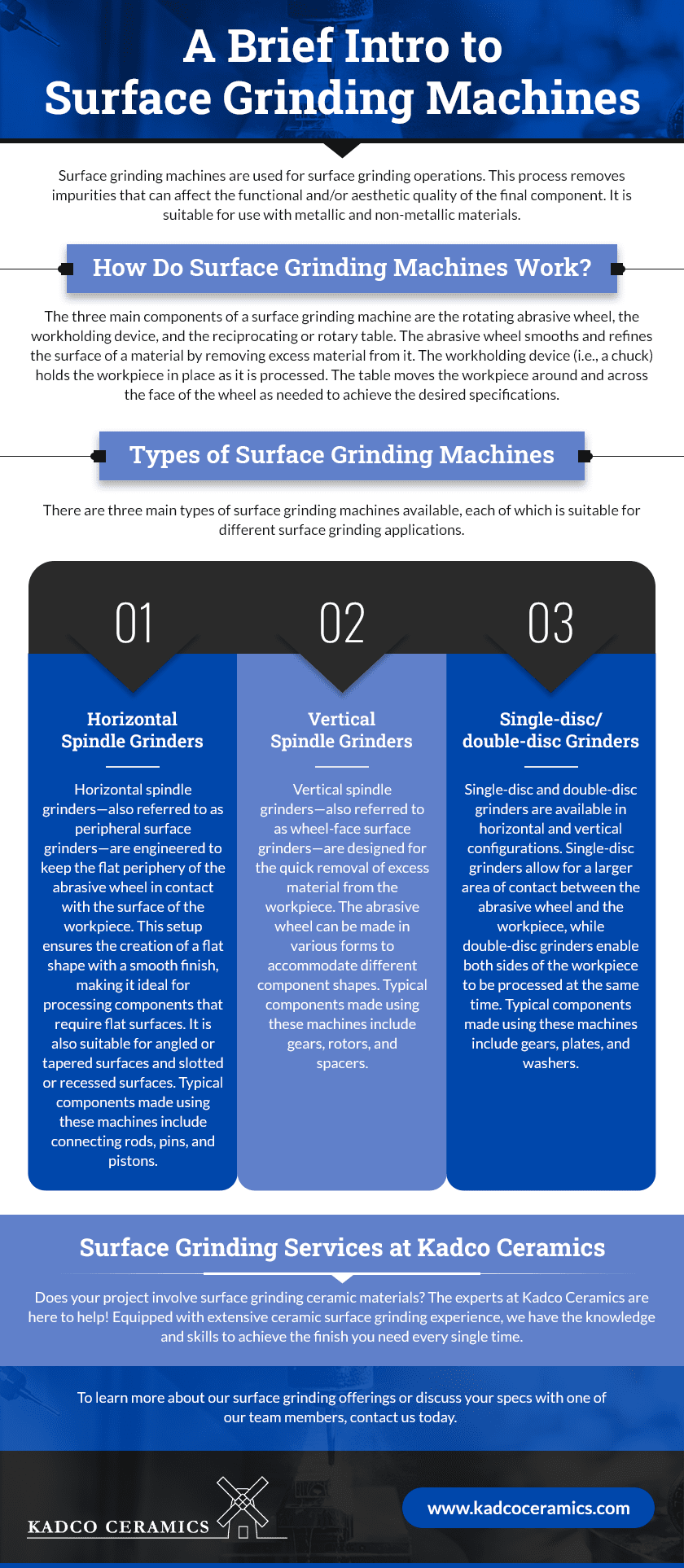A Brief Intro to Surface Grinding Machines
Leave a CommentSurface grinding machines are used for surface grinding operations. This process removes impurities that can affect the functional and/or aesthetic quality of the final component. It is suitable for use with metallic and non-metallic materials.
How Do Surface Grinding Machines Work?
The three main components of a surface grinding machine are the rotating abrasive wheel, the workholding device, and the reciprocating or rotary table. The abrasive wheel smooths and refines the surface of a material by removing excess material from it. The workholding device (i.e., a chuck) holds the workpiece in place as it is processed. The table moves the workpiece around and across the face of the wheel as needed to achieve the desired specifications.
Types of Surface Grinding Machines
There are three main types of surface grinding machines available, each of which is suitable for different surface grinding applications.
- Horizontal spindle grinders. Horizontal spindle grinders—also referred to as peripheral surface grinders—are engineered to keep the flat periphery of the abrasive wheel in contact with the surface of the workpiece. This setup ensures the creation of a flat shape with a smooth finish, making it ideal for processing components that require flat surfaces. It is also suitable for angled or tapered surfaces and slotted or recessed surfaces. Typical components made using these machines include connecting rods, pins, and pistons.
- Vertical spindle grinders. Vertical spindle grinders—also referred to as wheel-face surface grinders—are designed for the quick removal of excess material from the workpiece. The abrasive wheel can be made in various forms to accommodate different component shapes. Typical components made using these machines include gears, rotors, and spacers.
- Single-disc/double-disc grinders. Single-disc and double-disc grinders are available in horizontal and vertical configurations. Single-disc grinders allow for a larger area of contact between the abrasive wheel and the workpiece, while double-disc grinders enable both sides of the workpiece to be processed at the same time. Typical components made using these machines include gears, plates, and washers.
Surface Grinding Services at Kadco Ceramics
Does your project involve surface grinding ceramic materials? The experts at Kadco Ceramics are here to help! Equipped with extensive ceramic surface grinding experience, we have the knowledge and skills to achieve the finish you need every single time. We offer a range of capabilities, including:
- Centerless end grinding
- Rotary grinding
- Grinding fixtures
To learn more about our surface grinding offerings or discuss your specs with one of our team members, contact us today.
A Brief Intro to Pressure Transducers
Leave a CommentPressure transducers—also known as pressure sensors or transmitters—are devices engineered to measure and display the pressure of fluid within a system. They play a vital role in many pieces of equipment that require precise pressure measurement to work effectively and/or efficiently, including aircraft, HVAC systems, and pumps.
How Do Pressure Transducers Work?
These devices work by converting pressure into analog electrical signals. They first measure the pressure of the fluid using a force collector (e.g., a flexible diaphragm that deforms when it is pressurized). This pressure measurement is then converted into an electrical output signal by a transduction element that uses a dependent resistive, capacitive, or inductive mechanism (e.g., a strain gage). Since the signal generated is proportional to the pressure, relaying it to controllers or programmable logic controllers (PLCs) enables trained facility workers to evaluate if the pressure is within an acceptable range.
There are many types of pressure transducers available. While basic models use strain gauges to measure the pressure acting upon them, advanced models use capacitance or piezoelectric sensors, which offer broader range, greater environmental suitability, and better precision.
Creating Pressure Transducers Using Precision Dicing and Machining
Piezoelectric pressure transducers convert applied pressures to electrical signals using components made from quartz, ceramic, or other similar materials. The pieces must be carefully manufactured to work as intended. That’s why many industry professionals to the machining experts at Kadco Ceramics. We have the knowledge, skills, and tools to handle piezoelectrical materials and turn them into precision components, such as pressure transducers.
Our piezoelectrical materials list includes:
- Berlinite
- Cane sugar
- Quartz
- Rochelle salt
- Topaz
- Tourmaline
Our machining capabilities include:
- Wafer dicing: a process used to separate small pieces of material—i.e., dice—from a semiconductor wafer
- CNC milling: a process that utilizes computerized machines and tools to create the desired components by removing excess material from the workpiece
- Core drilling: a process that removes a cylindrical core from the drilled hole
- ID slicing: a process that produces repeated cuts on hard, brittle material
- Surface grinding: a process that uses an abrasive disc or wheel to smooth and refine the surface of a material
Kadco Ceramics: Your Partner and Expert for Piezoelectric Pressure Transducers
Need piezoelectric pressure transducers? The piezoelectric machining experts at Kadco Ceramics are here to help! Our precision dicing and machining capabilities enable us to handle virtually any hard or soft material and turn it into a range of precision end products, including pressure transducers. To discuss your product specs with one of our representatives, contact us today.

 Thomas Registered Supplier
Thomas Registered Supplier

